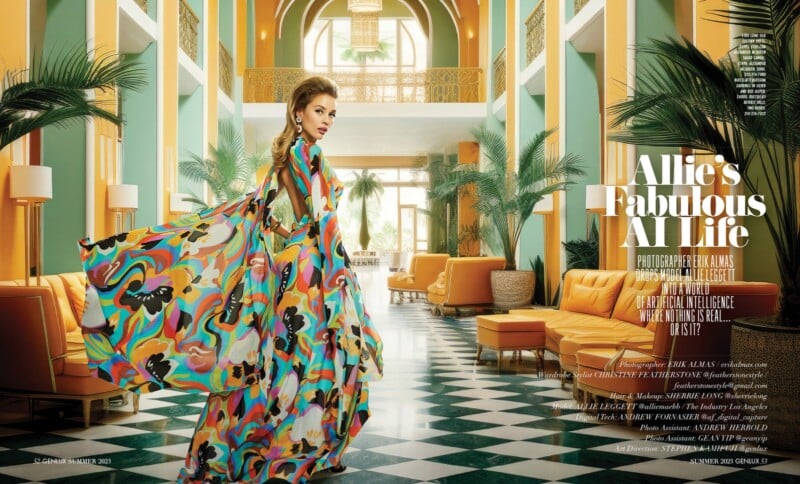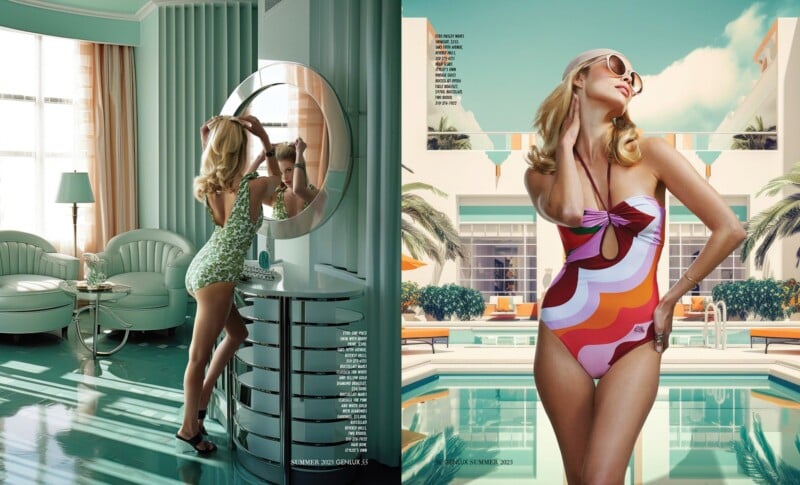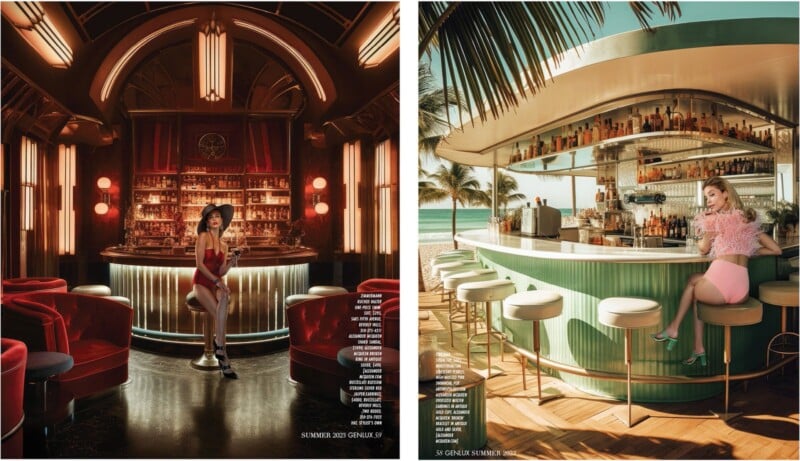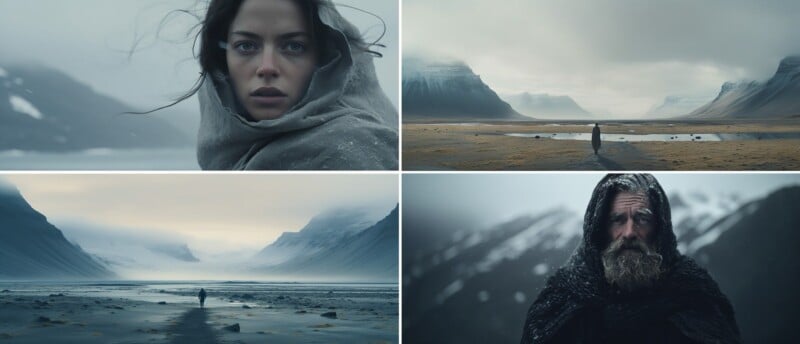![]()
AI is all the buzz and it seems to be attaching itself to everything, everywhere, all at once. The canary in the AI coal mine? Images and writing.

I feel ambivalent about my relationship with AI-generated imagery.
On one side, AI is nothing short of magic. It will conjure an image depicting whatever you tell it. The results are often surprising, and every now and then, astonishing. This gets the dopamine going, and me prompting, chasing my visual curiosity down the AI rabbit hole.
On the other side, AI is greatly unfulfilling. I am a craftsman as much as an artist, and typing descriptive words takes away the tactile element of craft. I am also pondering where in this process I am the creator, or even creative. Is AI wrapping me in a warm fuzzy feeling of creating images when I am hardly creating anything at all?
Am I instigating something artful? For sure. The better question, however, is: Am I the maker of this art?
Prompting on a computer is creatively passive, and chasing visual magic by waiting for an image to appear on screen inevitably leaves me feeling hollow and numb… which is the direct opposite of the sensation I get when doing my craft.
I was an early adopter of Photoshop and digital photography. My start in the fall of 1995 made me part of the first generation of photographers who were using the digital darkroom and Photoshop as an extension of our photography. This later led to CGI and incorporating generated elements into my images. AI can seem like the natural progression of digital photography, but is it?
Genlux Fashion Editorial


I have created some of my signature images with Stephen Kamifuji, the founder and Creative Director of Genlux Magazine. Stephen reached out after I shared some AI images online and asked if we could use AI in a fashion editorial for Genlux. This was the right place and opportunity and we jumped right in!
The upcoming issue was summer swim fashion. After some back and forth we settled on a 1930s Miami Beach Art Deco story. In past assignments for Genlux, my team had built sets and full-scale CGI environments to create the scenes we wanted. For this issue, the background images were created by prompts into the Midjourney bot describing time and space, architectural and cultural influences, and photography and light references.
The process of creating these backgrounds is astonishingly simple compared to what one had to do in the past to achieve the same setting. Is it as fun and hands-on? Is it progress? Not nearly as fun, but with the efficiencies it presents in creating environments that transport you to a different era, its adaption is inevitable…
Stephen, my stylists Christine and Sherrie, and I picked the backgrounds that we felt fit together in style, palette, and narrative. We then photographed the talent in my little studio in Sonoma, CA, matching light and perspective to seamlessly integrate our model into the different settings/backgrounds.
Experimenting with AI for this project, tapping into its visual wonder without losing craft and the creative connectedness of people collaborating, felt a lot more authentic to my process. The Art Deco background images were created using Midjourney and Topaz Giga Pixel was used to upres the images to a pixel size high enough for magazine print. In some cases, I used generative fill in Photoshop to remove items within the frames and I also combined several AI images to make the backgrounds,
In many ways this shoot transformed my AI experience from a passive, numbing, computer process, to a tool; a part of MY process and craft. During every composite shoot, I do a quick assembly on set to make sure the perspectives and light on the talent match up with the background they are being placed into. Watching this process, Stephen Kamifuji asked; “is this the future of Fashion Photography?”


We went from traditional film to digital cameras to phone cameras and digital distribution platforms in less than 15 years (From the first viable digital capture with the Kodak DCS series to Web 2.0 with blogs and social media. The AI tide has just started its rise and it will impact photography, and our lives, at a pace that will make these past 15-20 years look glacial. Listening to AI luminaries like Mo Gawdat, Vinod Khosla, and Mustafa Suleyman is both riveting and scary. According to them and others, AI will iterate exponentially, at a pace faster than we can Imagine, and AI will be “everywhere” in just a few years.
A few months back I wrote that AI can not replace the energy, feeling, emotion, connection, and all those intangible elements that we photographers capture in pictures. I now believe it can and it won’t be long until AI can recreate any emotional expression with a consistency only achieved by the best directors and actors…
Looking at what is possible to create with AI today and the pace of improvement, one can easily see a not-so-distant future where AI creates images so authentic one can’t distinguish them from real people or photography.
This leads me to ask; Will AI then ever be a tool for photographers if AI itself can create equal to us at near zero cost?

Where Do We Go From Here?
Even though impressive, AI is very basic in its generation of low-resolution pictures. The quality increase over the past 2 years has been astonishing, but from a photographer’s perspective, we have very little input on details that can help shape an artist’s personal vision.
I do believe AI will quickly mature into more of a creator’s tool. We can easily imagine AI building and mapping 3D environments as effortlessly as it creates images today.
In a 3D space, we can set our camera, choose lenses, set light and tone, alter perspective and angles, set color palette, etc. Today this is a tedious process of building wireframes and applying textures. What if we can create a Cinema 4D or Unreal Engine environment with the same prompts we give Midjourney? We are then in a digital “camera” environment that will allow us to make the same choices we make with the camera today. Rather than passively waiting for a picture to appear we can then digitally shape light, create feeling and atmosphere, and energy.
I’m sure this progression is just around the corner and in this capacity AI will be an extraordinary tool for any creative. Can you imagine having similar possibilities to create what Disney did with The Mandalorian in a few short years?
I don’t want to take this article too far into the future, but I have to mention the obvious; This AI 3D progression plays right into the evolution of Meta Quest and Apple Vision Pro. With time these devices will be closer in size to ordinary glasses and completely change how we interact with media. What if the 2D flat surface of magazines and screens gets largely displaced by an interactive and 3-dimensional space interacted with through a pair of shades? What will assignment and commercial photography be like in this 3D world? Will it exist or have we been bypassed by art directors getting their ideas visualized by AI in minutes?
One can easily connect the dots between Midjourney, what Unreal Engine does in 3D, and the Apple Vision Pro. In a short time, we will put on a headset and be transported into any environment, having any experience we want.
Are we heading to a reality we saw in Cline and Spielberg’s “Ready Player One”? As with most things AI, I get both excited and nervous about what’s to come…
The Elephant in the Room

The elephant in the room is obvious; Will AI put us photographers out of work?
That AI will take work from all levels of photographers is clearly evidenced by simple headshot generators like studioshot.ai, fashion model generator Lalaland.ai, and WPP, the largest advertising agency in the world “going all in on AI”
If this is just the beginning, where does this take us photographers?
AI will massively disrupt our commercial work and income, but I am not sure it is all bleak in the near term.
As consciousness around AI and skepticism around what is real and fake gets embedded into our culture I believe companies will be reluctant to choose AI in their brand imagery.
The core of a company’s marketing is centered around its identity and its story. High on any marketer’s list is to express the company’s ethos through authenticity and values. Would we as consumers trust a brand narrative if it was represented by an AI-generated person?
I believe the answer is yes and no; Conceptual work, which represents or illustrates ideas or concepts, will go the way of AI in short order. Like the elephant in the room images above…
I can’t imagine however a hospitality brand in the business of selling experiences would choose to use AI in its marketing. AI is the polar opposite of the human experience hospitality is all about, and using AI could truly tarnish a brand if they went that route.
The same goes for healthcare, which represents one of the largest segments of advertising spend in the US. Can you imagine an advertising image where the message is to make us healthier, using images with AI-generated people?
Neither can most.
The beginning of this sentiment can be felt in the backlash towards Levi’s when they announced they were partnering with Lalaland.ai to “increase Diversity” using AI-generated models. Visiting lalandia.ai gives a clear idea of what’s to come and where things are heading when it comes to catalog and product photography.
Another barrier to the commercial proliferation of AI-generated images is the demand for the work to be watermarked. Would you be excited to eat an Orio cookie if the advertising image was marked “AI generated”? Would we be just as excited to buy the cookie when it’s marked as “not real”?
These barriers to AI entering advertising however are placed on the consumer’s perception. What if that fake Orio triggers our salivary glands just as much as a picture of a real one?
The advertising agencies have no doubt this is where the making of marketing content is heading;
“Generative AI is changing the world of marketing at incredible speed. This new technology will transform the way that brands create content for commercial use,” WPP CEO Mark Read said in a statement. (WPP= Ogilvy, Grey, AKQA, Wunderman,Y&R, and some 50 other agencies)
AdvertisingWeek is supporting this future, recently publishing an article titled “Harness the Power of AI-Generated Images: The Ultimate Marketing Solution.”
Does anyone truly believe AI to be the ultimate marketing solution? I would think human connection is the ultimate, but what about mass marketing?
The public perception around what is real and what is fake will surely be magnified as AI images get close to indistinguishable from captured photography and I hope both consumers and companies with values around authenticity will be cautious in their use of AI.
The real question however is; Do we care? Hasn’t advertising always created a manufactured truth to stir up desire?
Reading The Independent’s article on Levi’s gives great insight into how large brands are looking for efficiencies and their approach to AI. They are largely brushing off the criticism, saying the use of AI “should not have been conflated with the company’s diversity, equity and inclusion commitment or strategy.” and, “Levi’s maintained that the new technology will enable customers to see more models that look like themselves, “creating a more personal and inclusive shopping experience”.
Interpret that one as you will, or ask one of Metas new celebrity chat bots for advice… I think I’ll pass on buying another Levi’s product.
Change
For the longest time, I identified as a photographer. That was what I did and who I was….
Mid 2019 I started feeling guilty for not paying enough attention to “my craft”. I constantly felt I should create new, and award-winning pictures in order to stay relevant. My creative gravity however pulled me towards renovating homes and making my first short film. I felt like I was wasting a lot of my time (which I still do at times), exploring architecture and design of spaces, rather than coming up with concepts for the next photoshoot.
I felt deeply that I owed it to my career, and to who I was, to create more images!
At the time I was working with a life coach and he helped me unlock the singular perception I had of myself and what it meant to be successful. In a short conversation, I went from being a photographer to being someone who “creates energy, feeling, emotion, and atmosphere in pictures, films and spaces”
It sounds so basic when spelled out, but it allowed me, without any guilt (mostly), to spend time on whatever creative outlet I wanted to pursue, rather than chasing the next picture and the next showcase so I could get the validation I craved.
I am sharing this story as I think it can help us to untie ourselves from our identity as photographers as AI starts finding its way into what has been our domain.
Because of my own untangling from my photographer identity and my dedication to time exploring architecture, design, and film, I have become an award-winning filmmaker, a renovator of homes that have been published in Dwell and Conde Nast Traveller and in turn a better photographer.
The point of this, not so humble brag, is that identifying with one thing is tough when this one thing is utterly disrupted.
AI will change assignment photography, but I believe there will be new ways for us to thrive as commercial artists!
Photography is truly just one way of expressing how we, as visual creative thinkers, absorb and relate to our surroundings. We can express our keen awareness of light and shape and composition and emotion and energy, and the list keeps going, in many other ways.
My work as a photographer will be massively impacted by AI, so I opt to be excited about the upcoming possibilities. How can we photographers thrive in this monumental change?
I believe it starts with acknowledging the change and getting on board with the AI toolkit. This Genlux Fashion Series is me getting on board, partaking in the AI image revolution, and exploring its current tools in a way, that for me, is creatively fulfilling…
Will I be replaced? For sure. But maybe not, all the time…
In writing this I reached out to a few Advertising Creative Directors and they all believe AI will replace a lot, if not most of today’s commissioned assignment Photography.
At this stage, they all use AI for visualizing concepts for comps and presentations to clients. As one Creative director put it; I don’t know if it will be five months or five years, but what we are doing for visualization/comps today will eventually be used as final art.
A different discussion in this is copyright. The licensing issues however will be sorted in very short order as Adobe Stock, Shutterstock, and Getty are all training AI image generators on their image libraries. With this, the copyright and ownership legal hurdle to commercially use AI images will be gone.
About the author: Erik Almas is a California-based advertising photographer who travels around the world shooting for clients like Kohler, Toyota, Puma, Nike, Hyatt, USPS, Citibank, and Amtrak. The opinions expressed in this article are solely those of the author. To see more of his work, visit his website, Facebook, and Instagram. This post was also published here.
